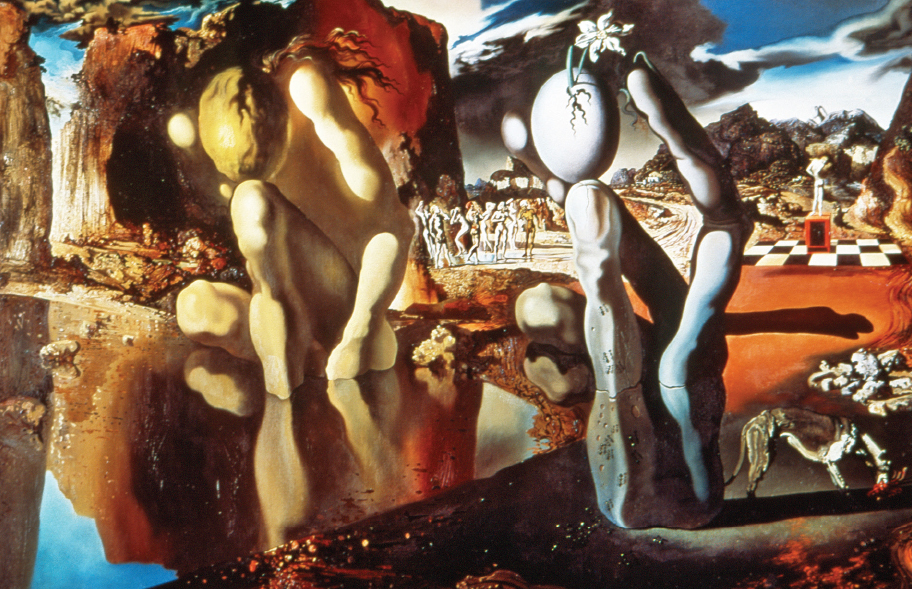New Artistic Movements
In the decades surrounding the First World War, the visual arts also experienced radical change and experimentation. For the last several centuries, artists had tried to produce accurate representations of reality. Now a new artistic avant-garde emerged to challenge that practice. Modern painting and sculpture became increasingly abstract as artists turned their backs on figurative representation and began to break down form into its constituent parts: lines, shapes, and colors.
One of the earliest modernist movements was impressionism, which blossomed in Paris in the 1870s. French artists such as Claude Monet (1840–1926) and Edgar Degas (1834–1917) and the American Mary Cassatt (1844–1926), who settled in Paris in 1875, tried to portray their sensory “impressions” in their work. Monet’s colorful and atmospheric paintings of farmland haystacks and Degas’s many pastel drawings of ballerinas exemplify the way impressionists moved toward abstraction. Capturing a fleeting moment of color and light, in often blurry and quickly painted images, was far more important than making a heavily detailed, precise rendering of an actual object.
In the next decades, an astonishing array of new artistic movements emerged one after another. Postimpressionists and expressionists, such as Vincent van Gogh (1853–1890), built on impressionist motifs of color and light but added a deep psychological element to their pictures, reflecting the attempt to search within the self and reveal (or “express”) deep inner feelings on the canvas.
After 1900, avant-garde artists increasingly challenged the art world status quo. In Paris, in 1907, painter Pablo Picasso (1881–1973), along with other artists, established cubism — a highly analytical approach to art concentrated on a complex geometry of zigzagging lines and sharply angled, overlapping planes that exemplified the ongoing trend toward abstract, nonrepresentational art. In 1909, Italian Filippo Tommaso Marinetti (1876–1944) announced the founding of futurism. According to Marinetti, traditional culture could not deal with the advances of modern technology and the way these had changed human consciousness. Marinetti embraced the future and cast away the past, calling for radically new art forms that would express the modern condition.

Salvador Dalí, Metamorphosis of NarcissusDalí was a leader of the surrealist art movement, which emerged in the late 1920s. Surrealists were deeply influenced by the theories of Sigmund Freud and used strange and evocative symbols to capture the inner workings of dreams and the unconscious in their work. In this 1937 painting, Dalí plays with the Greek myth of Narcissus, who fell in love with his own reflection and drowned in a pool. What mysterious significance, if any, lies behind this surreal reordering of everyday reality? (The Granger Collection, New York. © Salvador Dalí, Fundacío Gala-Salvador Dalí, Artists Rights Society (ARS), New York 2013)
The shock of World War I encouraged further radicalization. In 1916, a group of artists and intellectuals in exile in Zurich, Switzerland, championed a new movement they called Dadaism, which attacked all the familiar standards of art and delighted in outrageous behavior. The war had shown once and for all that life was meaningless, the Dadaists argued, so art should be meaningless as well. Dadaists tried to shock their audiences with what they called “anti-art,” works and public performances that were insulting and entirely nonsensical. After the war, Dadaism became an international movement, spreading to Paris, New York, and particularly Berlin in the early 1920s.
During the mid-1920s, some Dadaists were attracted to surrealism. Surrealists such as Salvador Dalí (1904–1989) were deeply influenced by Freudian psychology and portrayed images of the unconscious in their art. They painted fantastic worlds of wild dreams and uncomfortable symbols.
Many modern artists sincerely believed that art had a radical mission. By calling attention to the bankruptcy of mainstream society, they believed, art had the power to change the world. The sometimes-nonsensical manifestos written by members of the Dadaist, futurist, and surrealist movements were meant to spread their ideas, challenge conventional assumptions of all kinds, and foment radical social change.
